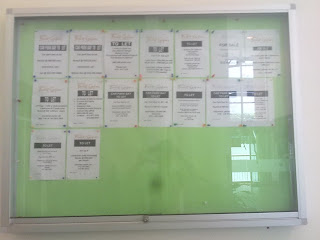picture above: The Nadayu site with the car workshops in the background
picture above: low cost flats beside the site
picture above: the Sunway College dorms
This project consists of 400 odd units, housed in 3 blocks. There are 3 designs... the 1650sf, 1850sf and the popular 990sf 2 bedroom units. At the time of my visit today, the 990sf were almost sold out leaving 3 units while the rest are almost 80% sold.
Although the developer is marketing these condominiums as luxurious family units, it is pretty obvious the design is targeting the lucrative student market here... For example, the 1850sf and the 1650sf are 4 and 3 bedroom units respectively. Every one of the bedrooms are of almost equal size, including the master bedroom and all of them are en-suite.
While viewing these units, it was a struggle for me to identify which room was actually the master bedroom. All the en-suite bathrooms also appear to be almost equal size and they are pretty small as family bathrooms....
So if I leave you the honour, would you be able to tell me which bathroom above belongs to a master bedroom?
And perhaps the biggest flaw of the design is the extremely small kitchen, with no wet kitchen. The sales people told me that their target is young couples who rarely cook and eat at home... but why would young couples buy into a large 4-bedroom condo in the 1st place?
But indeed the student market in Sunway is extremely lucrative, even for high quality expensive ones. We reviewed one recently, the Sunway Palmville. Rent here is around RM3500/month which means a student bedroom without en-suite facilities can fetch as high as RM750 to RM1000/month. Apparently, I've been told, Indonesian students tend to pay their rent up to 6 months in advance to secure their rooms. Palmville however is not as popular as Lagoonview pictured below... Here I heard, rooms get snapped up as soon as they become vacant and the rent is even higher than Palmville.
So, it's not a coincidence that Nadayu28's design is leaning towards this market.
Student market or not, I feel the architect should have done better with the layout. There is quite a lot of wasted space, especially at the main entrance. They could have done away with the maid room/bathroom and the powder room to enlarge the kitchen.
picture above: The main entrance corridor with powder room on the right
picture above: The maid room
With a quick calculation, the 1850sf is going for about RM1.2million.... they are offering a 10% + 5% discount, which means you can land one for just over RM1million. Assuming these super luxurious student rooms can be rented out at RM1200/month per room, that will bring you about 5% returns after costs. With that in mind, the 990sf units at about RM700k is not really that worthwhile because there are only 2 rooms.
With these 3 "powerful" colleges in the vicinity - Sunway, Monash and Taylors, there is no doubt it is the investment strategy. So Nadayu should quit "fooling" us that we're buying into a luxurious family condominium project.



























